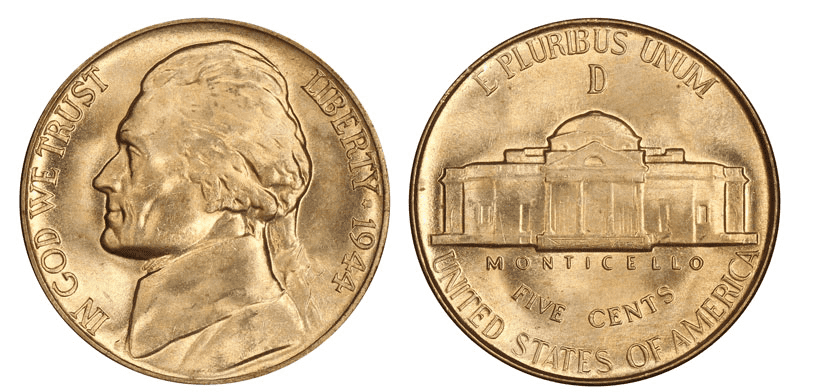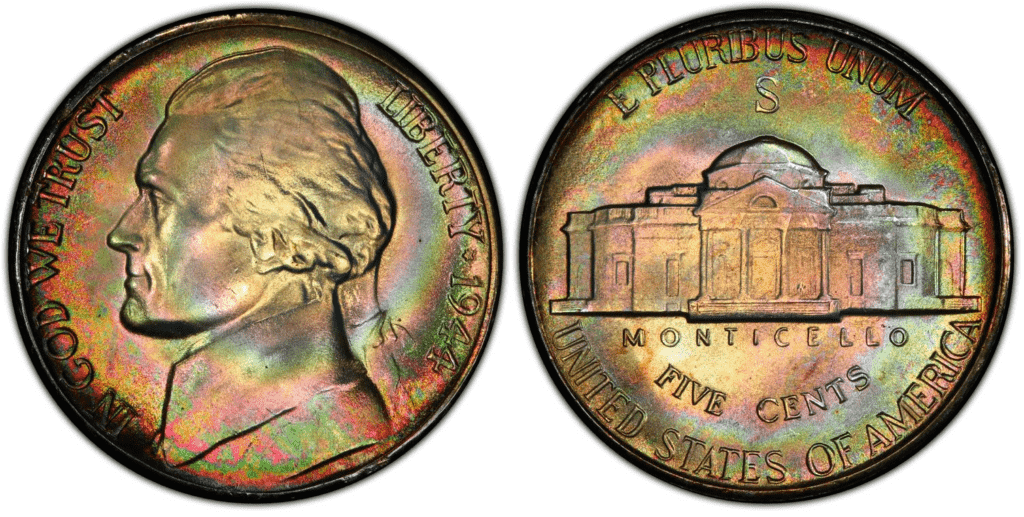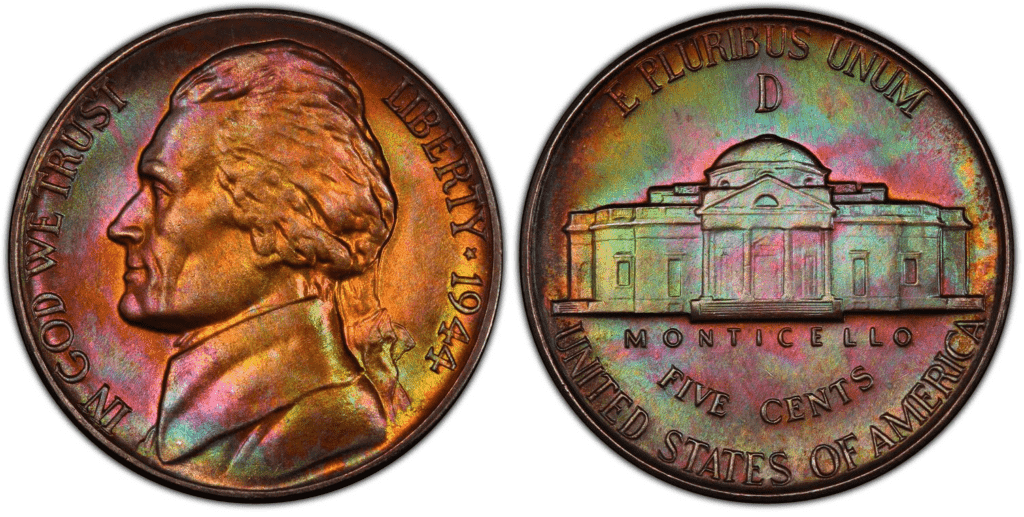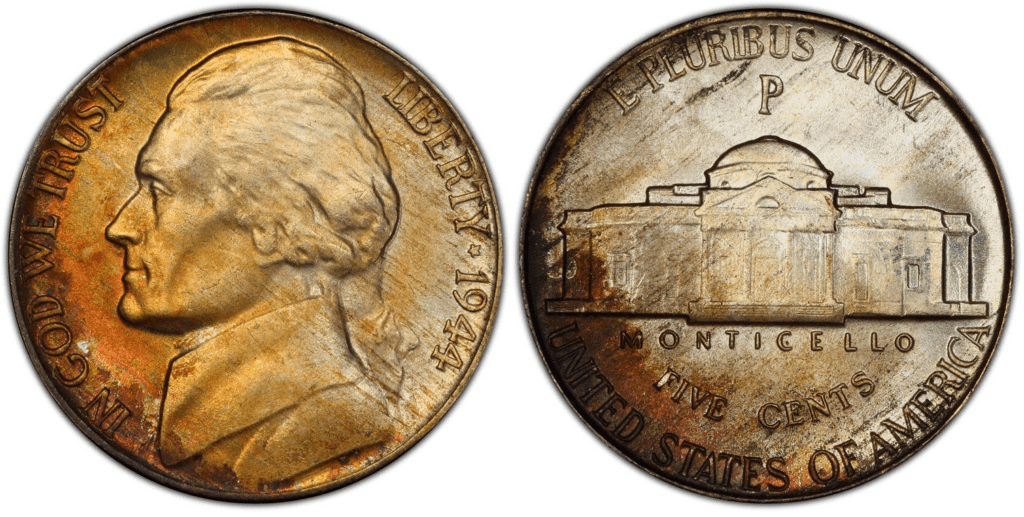What Is the 1944 Jefferson Nickel Made Of?
The Jefferson nickel has been the five-cent coin the United States Mint issued since 1938 when it replaced the Buffalo nickel. Although the Buffalo nickel looked amazing, it was difficult to mint. Thus, when the time was right, the US Mint decided to replace it with the Jefferson Nickel.
From 1938 to 2004, the copper-nickel side of the coin featured a profile portrait of Founding Father and third US President Thomas Jefferson by artist Felix Schlag. The model used in 2005 is also in profile, but this time, it was a design made by Joe Fitzgerald.
The Mint produced shell case cents from 1944 to 1946, whereas steel cents were only for a single year. Nickels produced during the war were 56% copper, 35% silver, and 9% manganese. Today, the composition of the Jefferson nickel is 75% copper and 25%

The obverse side of the nickel shows the left profile of Thomas Jefferson, the image is based on a Rembrandt Peale portrait completed in 1800. Also engraved is the US motto, “IN GOD WE TRUST,” “LIBERTY,” and the year “1944.”
On the reverse, you will find an image of Jefferson’s mansion, popularly known as the Monticello. An inscription on this side includes “E PLURIBUS UNUM,” Latin for “Out of many, one” — a traditional motto for the US. Other inscriptions include the following:
- Five Cents
- United States America
- Mint mark (if present)
Perhaps, what’s interesting about the 1944 nickel is its mintmarks. The mintmark is a small letter indicating where the coin was struck. Yet, in this series, the mint marks are more prominent. Not only that, but even the Philadelphia Mint, which normally doesn’t add a mint mark, added its mark on the coin.
1944 Jefferson Nickel Varieties
Through its three primary mint facilities, which are situated in Denver, Philadelphia, and San Francisco, the US Mint created the 1944 Jefferson nickel. The principal distinctions between the 1944 variations are their mint markings and the location in which they are struck.
The names of the 1944 variants are 1944-D, 1944-P, and 1944-S. During coin production, the mint also made mistakes, leading to the production of some error coins. The quantity of Jefferson nickels produced varied at each mint facility.
Refer to the table below for the summary:
| Variety | Location | Mintage |
| 1944-S Jefferson Nickel | San Francisco | 21,640,000 |
| 1944-D Jefferson Nickel | Denver | 32,309,000 |
| 1944-P Jefferson Nickel | Philadelphia | 119,150,000 |
| Total | 463,889,000 |
Since it is a modern coin, there is no truly rare Jefferson nickel. However, the 1944-S mintage of the War Nickel silver series is the second lowest.
The 1944-P Jefferson nickel, one of the most common dates of the silver alloy subtype, was struck at a time of war from alloy created to save copper and nickel.
In the 1950s, this subtype is one of the nickels counterfeited by an engineer in Philadelphia named Francis LeRoy Henning, later called “Henning nickels.”
Henning overlooked the big “P” mint mark over Monticello, which drew the attention of vigilant customers, enthusiasts, and law enforcement. The Director of the Mint in Washington, William Brett, also discovered a flaw in the “R” in “PLURIBUS.”

Check out the descriptions below to discover more about these 1944 Jefferson nickel varieties:
1944-S Jefferson Nickel
Edge: Smooth
Mint Mark: S
Place of minting: San Francisco
Year of minting: 1944
Face Value: $0.05 (five cents)
Price: $1.64 to $23 (or more)
Quantity produced: 9,796,000
Designer: Felix Schlag
Composition: 56% Copper, 35% Silver and 9% Manganese
Mass: 5 grams
Diameter: 21.21 mm
Thickness: 1.95 mm

The San Francisco mint is the 1944 mint with the lowest production. Special emphasis is focused on evaluating the condition of these silver nickels because there were 21,640,000 manufactured.
The prominent “S” mintmark over the dome of Monticello on the reverse identifies the San Francisco edition. Silver alloy 1944 nickels come with a substantial premium based on the price of silver.
Furthermore, they become rather challenging in grades MS67 and MS68. Depending on their condition, 1944-S nickels cost between $1.64 to $23.
1944-D Jefferson Nickel
Edge: Smooth
Mint Mark: D
Place of minting: Denver
Year of minting: 1944
Face Value: $0.05 (five cents)
Price: $8 to $750(or more)
Quantity produced: 9,796,000
Designer: Felix Schlag
Composition: 56% Copper, 35% Silver and 9% Manganese
Mass: 5 grams
Diameter: 21.21 mm
Thickness: 1.95 mm

There are several worn-out 1944 Denver nickels that are common and are worth silver. Elite grades are even more valuable than silver when they are in perfect condition.
1944-D nickels range in price from as low as $8 to as high as $750.
1944-P Jefferson Nickel
Edge: Smooth
Mint Mark: P
Place of minting:Philadelphia
Year of minting: 1950
Face Value: $0.05 (five cents)
Price: $2.50 to $25 (or more)
Quantity produced: 9,796,000
Designer: Felix Schlag
Composition: 56% Copper, 35% Silver and 9% Manganese
Mass: 5 grams
Diameter: 21.21 mm
Thickness: 1.95 mm

Since the Mint produced more than 119 million of the 1944-P Nickel, it is prevalent in circulated grades. They are easily accessible and cost less than $25 in MS60–MS66 quality. However, the ones in MS67 condition are rare, with only four dozen or so remaining. There are also no known MS68s.
List Of 1944 Jefferson Nickel Errors
1944 saw the production of more than 463 million pennies, as was already mentioned. With such a massive mintage, it should go without saying that some coins would inevitably have errors.
Here’s an overview of some of those blunders:
Doubled Die Nickels
Sometimes, when a coin’s die is made using a hubbing machine, the design is unintentionally engraved twice at two slightly different angles. Every coin made by the doubled die at that point will also demonstrate doubling
Doubled dies visible to the unaided eye are the most valuable among errored coins. However, you can only find minor doubled dies in 1944 nickels with the help of 5x amplification. Prices start at $25 and go up to $100 or even more.
Repunched Mintmarks
Officials from the U.S. Mint used to manually punch each mintmark onto a die back in the 1940s. There was a lot of possibility for error in this, such as mintmarks that were slightly off-center, double punched, sideways, etc. These repunched mintmark types are all truly rare and worth a little money.
Common repunched mintmark variations with doubled mintmarks sell for $3 to $5. The value of these pieces can range from $50 to $100 and beyond for those that have tripled, quadrupled, or a perfectly positioned mintmark over one that is positioned incorrectly.
Off-Center Nickels
Off-center mistakes are astonishing anomalies in which a portion of the design is absent due to either a misalignment of the coin with the dies on the presses or a misalignment of the dies themselves.
It becomes more valuable if more portions of the design are missing.
As for the price range, when 5%-10% of the design is missing, it costs between $5 to $10. When 50% of the design is gone but has a clear date, its value is around $50 to $100 or even more.
Older variants could also cost more.
Henning Nickels
The counterfeit 1944 Henning Nickels that were mentioned earlier are also an example.
Henning made imitations of the 1944 nickels and those minted in 1939, 1946, 1947, and 1954. Writers coined his Mint as the “Erial Mint.” because he created these counterfeits in a building in Erial, New Jersey.
In December 1954, the counterfeits were reported to the US Secret Service. They eventually located the Erial Mint, where they spoke with Henning’s coworkers and learned of his relocation to Cleveland. This eventually led to his arrest on October 27, 1955, and he was sentenced to three years in prison.
Henning nickels are affordable. And high-grade imitations are priced at less than $100.
How Much Is The 1944 Jefferson Nickel Worth Today?
The 1944 Jefferson nickel has a face value of $0.05. And as of January 11, 2023, its melt value is $1.34. If you’re only basing value on those two factors, there is no denying that it is not very valuable.
The 1944 Jefferson nickel’s perceived value, however, is what matters most. Remember that finding this coin in modern culture is difficult because it is really old, particularly if you’re shopping for good-quality coins.
To get a better idea of the pricing of this coin, here’s a 1944 Jefferson nickel values chart:
| Coin | Condition | Grade | Mintage | Value |
| 1944 D Jefferson Nickel | Good | G-4 to G-6 | 9,796,000 | $0.10 |
| 1944 D Jefferson Nickel | Fine | F-12 to F-15 | 9,796,000 | $1 |
| 1944 D Jefferson Nickel | Extremely Fine | XF-40 to XF-45 | 9,796,000 | $2.50 |
| 1944 D Jefferson Nickel | Uncirculated | MS-60 to MS-62 | 9,796,000 | $3 |
| 1944 D Jefferson Nickel | Gem Uncirculated | MS-65 to MS-66 | 9,796,000 | $15 to $46 |
| 1944 D Jefferson Nickel | Superb Gem Uncirculated | MS-67 to MS-68 | 9,796,000 | $49 to $1,058 |
| 1944 D Jefferson Nickel | Superb Gem Uncirculated – Full Step | MS-67 to MS-68 | 9,796,000 | $94 to $10,575 |
| 1944 S Jefferson Nickel | Good | G-4 to G-6 | 21,640,000 | $0.10 |
| 1944 S Jefferson Nickel | Fine | F-12 to F-15 | 21,640,000 | $1 |
| 1944 S Jefferson Nickel | Extremely Fine | XF-40 to XF-45 | 21,640,000 | $2.50 |
| 1944 S Jefferson Nickel | Uncirculated | MS-60 to MS-62 | 21,640,000 | $22 |
| 1944 S Jefferson Nickel | Gem Uncirculated | MS-65 to MS-66 | 21,640,000 | $8 to $53 |
| 1944 S Jefferson Nickel | Superb Gem Uncirculated | MS-67 to MS-68 | 21,640,000 | $81 to $1,645 |
| 1944 S Jefferson Nickel | Superb Gem Uncirculated – Full Step | MS-67 to MS-68 | 21,640,000 | $458 to $14,100 |
| 1943 P Jefferson Nickel | Good | G-4 to G-6 | 119,150,000 | $0.10 |
| 1944 P Jefferson Nickel | Fine | F-12 to F-15 | 119,150,000 | $1 |
| 1944 P Jefferson Nickel | Extremely Fine | XF-40 to XF-45 | 119,150,000 | $2.50 |
| 1944 P Jefferson Nickel | Uncirculated | MS-60 to MS-62 | 119,150,000 | $3.25 |
| 1944 P Jefferson Nickel | Gem Uncirculated | MS-65 to MS-66 | 119,150,000 | $10 to $45 |
| 1944 P Jefferson Nickel | Superb Gem Uncirculated | MS-67 | 119,150,000 | $69 to $180 |
| 1944 P Jefferson Nickel | Superb Gem Uncirculated – Full Step | MS-67 | 119,150,000 | $264 to $881 |
As you can see, the 1944 Nickel can be expensive if given the right condition, grade, and rarity. To see the real potential of the 1944 nickel in terms of pricing, check out the auction records for each variety:
- $22,325 – a 1944-D 5C, FS (Regular Strike) coin with a grade of MS68 sold in August by Stack’s Bowers
- $14,100 – a 1944-S 5C, FS (Regular Strike) coin with a grade of MS68 sold in October 2015 by Heritage Auctions
- $9,400 – a 1944-P 5C, FS (Regular Strike) coin with a grade of MS67+ sold in March 2014 by Heritage Auctions
How Does The Grading System Work?
The Sheldon Scale is used by numismatists to provide a numerical value to coins. The Sheldon Scale goes from poor (P-1) to perfect mint state (P-1) (MS-70). Coins were originally evaluated using words to reflect their condition (Good, Fair, Excellent, Etc.). Unfortunately, coin collectors and dealers had different ideas about what each of these terms represent.
Professional numismatists joined together in the 1970s and established CoinGrading standards. These numismatists now assign grades at key places on the seventy-point scale, using the most regularly utilized numeric points in conjunction with the original adjective grade. The following are the most common coin grades:
-
-
- (P-1) Poor – Indistinguishable and probably damaged; if used, must have a date and mintmark; otherwise, rather battered.
- (FR-2) Fair – Nearly smooth, but without the damage that a coin graded Poor often possesses. The coin must have enough detail to be identified.
- (G-4) Fair – Inscriptions have merged into the rims in some areas, and important elements have been mostly erased.
- (VG-8) Very Good- A little weathered, but all of the primary design elements are visible, albeit faintly. There is little if any, central detail left.
- (F-12) Good – The item is very worn, yet the wear is even, and the overall design details stand out clearly. Rims are almost completely isolated from the field.
- (VF-20) Very Fine – Moderately weathered, with some finer features still visible. The motto or all letters of LIBERTY are readable. Both sides of the coin have entire rims that are separated from the field.
- (EF-40) Extremely Fine – Gently used; all gadgets are visible, and the most important ones are bold. The finer details are bold and clear, however, light wear may be seen.
- (AU-50) Uncirculated – Slight evidence of wear on the coin’s design’s high points; may have contact marks; eye appeal should be adequate.
- (AU-58) Uncirculated Choice – Slight traces of wear, no severe contact marks, almost full mint shine, and great eye appeal.
- (MS-60) Mint State Basal – Strictly uncirculated; no indication of wear on the coin’s highest points, but an unsightly coin with reduced luster, visible contact marks, hairlines, and other flaws.
- (MS-63) Mint State Acceptable – Uncirculated, but with contact scratches and nicks, little reduced shine, but otherwise appealing appearance. The strike is weak to average.
- (MS-65) Mint State Choice – Uncirculated with great mint shine, very little contact blemishes, and exceptional eye appeal. The strike is unusually severe.
- (MS-68) Mint State Premium Quality – Uncirculated with superb luster, no obvious contact marks to the naked eye, and exceptional eye appeal. The strike is quick and appealing.
- (MS-69) Almost Perfect Mint State – Uncirculated with perfect brilliance, a sharp and appealing strike, and extremely good eye appeal. A near-perfect coin with minor imperfections in the planchet, strike, and contact markings (seen only under 8x magnification).
- (MS-70) Mint State Perfect – Under 8x magnification, there are no tiny imperfections discernible; the strike is crisp, and the coin is perfectly centered on a beautiful planchet. Rarely seen on a coin, this coin is bright and whole, with original luster and exceptional eye appeal.
-
Where To Buy Or Sell 1944 Jefferson Nickel?
You can find 1944 Jefferson nickels on online sites such as Amazon and eBay. You may also choose to sell them there. Aside from these platforms, there are various websites that specialize in both buying and selling coins. These websites include Coin Appraiser, Grey Sheet, and USA Coin Book, to name a few.
Of course, there are some drawbacks to buying or selling coins online. For one, you can only see the coin in pictures or videos. If you’re selling coins, you can see your buyer in person. Not only that, but there are scammers online that you need to be wary about.
If the Internet is not for you, you can also go to coin shops, pawnshops, and antique stores. Join live auctions as well.
FAQs
Where is the mint mark on a 1944 nickel?
You can find the mint mark on the 1944 Jefferson nickel on the reverse side, just above the Monticello. It could either be “S” for San Francisco, “D” for Denver, or “P” for Philadelphia.
Is there anything special about a 1944 nickel?
The 1944 nickel was made of silver, which most current coins don’t have. Thus, compared to modern coins, the 1944 nickels are special. Not only that, but a 1944 nickel is an old coin, which makes it more difficult to find than earlier issues. 1944 nickels also become more special when they are in a good condition and possess rare attributes.
